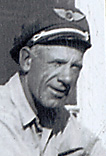 J.C. "Pappy" Hoel was a racer, motorcycle dealer and race promoter, but his lasting legacy is the Black Hills Classic Rally held annually in Sturgis, South Dakota. In 1938, Hoel founded what would become one of America’s most famous motorcycle rallies. While that first rally in 1938 attracted 200 participants, Sturgis would go on to become a mega-rally hosting well over 100,000 riders each year and pumping millions of dollars into the Sturgis area's economy.
J.C. "Pappy" Hoel was a racer, motorcycle dealer and race promoter, but his lasting legacy is the Black Hills Classic Rally held annually in Sturgis, South Dakota. In 1938, Hoel founded what would become one of America’s most famous motorcycle rallies. While that first rally in 1938 attracted 200 participants, Sturgis would go on to become a mega-rally hosting well over 100,000 riders each year and pumping millions of dollars into the Sturgis area's economy.
Hoel was born in South Dakota on May 30, 1904. He grew up working in his family’s ice business. In the 1930s, refrigerators were becoming all the rage and Hoel saw that working in ice had little future. In 1936, Hoel purchased an Indian franchise and opened his motorcycle shop in Sturgis. The next year, he founded the Jackpine Gypsies Motorcycle Club.
One of the club’s first functions was to host a Gypsy Tour through the scenic Black Hills of South Dakota. "The Black Hills Motor Classic" kicked off in the summer of 1938. Camping was provided in "Pappy" and Pearl Hoel's back yard, behind their Indian Motorcycle Shop on Junction Avenue in Sturgis. The event was "catered" by Pappy's wife, Pearl, and the wives of the other charter club members. A dirt track race was held in conjunction with the rally and the star rider was an up-and-coming Indian-backed rider from Milwaukee named Johnny Spiegelhoff.
Pearl remembered the menu of that first year: "Weenies, sloppy joes, potato salad and
watermelon for dessert." The rally riders washed their free meal down with iced tea or coffee, served in a tent behind the Hoels’ garage at their dealership.
The rally proved to be so popular that it quadrupled in size the next year. The 1939 rally hosted 800 riders. The growth was largely due to "Pappy" Hoel’s personality. He was a charismatic man and a motorcycle evangelist. His nickname came from the dozens of young men he recruited to the sport. Hoel persuaded a number of young men to buy motorcycles. In fact, in 1947, he sold more Indian bikes per capita than anyone in the nation. Hoel was passionate about bikes and a mentor to a generation.
The rally lost two years during World War II, but renewed after war’s end. In the 1950s, Sturgis grew slowly. It drew approximately 1,000 participants by the end of the 1950s. The emphasis was always on racing. Hoel directed the club to branch out to run scrambles (later motocross) and hillclimbs as well as the traditional flat track races as part of the rally.
After Hoel’s beloved Indian died in the late-1950s, his shop began selling other brands, including what would become its primary line, Yamaha.
By the early-1970s, the face of the rally was changing. So-called outlaw biker gangs took over the rally from the more racing- and family-oriented motorcyclists of previous years.
Sturgis city fathers suggested to Hoel that the outlaw gangs not be allowed to enter the city during the rally. Hoel rejected that idea, arguing that the "gangs" had done nothing wrong and that they should be allowed to participate. Hoel only seemed to see the good side of all riders. They were, after all, motorcyclists.
Over the years, Hoel’s Jackpine Gypsies shouldered civic responsibility in numerous ways.
They donated to the City of Sturgis thousands of yards of fill dirt for construction of the Sturgis Community Center and parking lot. They have held membership in the Sturgis Chamber of Commerce for more than twenty years, providing personnel to various Chamber committees.
Hoel won numerous citations from civic and tourism organizations. August 14, 1983 was even proclaimed J.C. "Pappy" Hoel Day in South Dakota.
In 1983, he received the AMA's Dud Perkins Award for outstanding contributions to motorcycling.
By the 1980s, the Sturgis rally had grown so large the Jackpiners could no longer run the event. It was turned over to the city and later to other commercial groups. When Hoel died in 1989, at the age of 84, Sturgis was drawing close to 100,000 rally goers and showing no signs of slowing down — a far cry from the free weenies and sloppy joes served behind the Hoels’ garage some five decades earlier.
Inducted in 1998